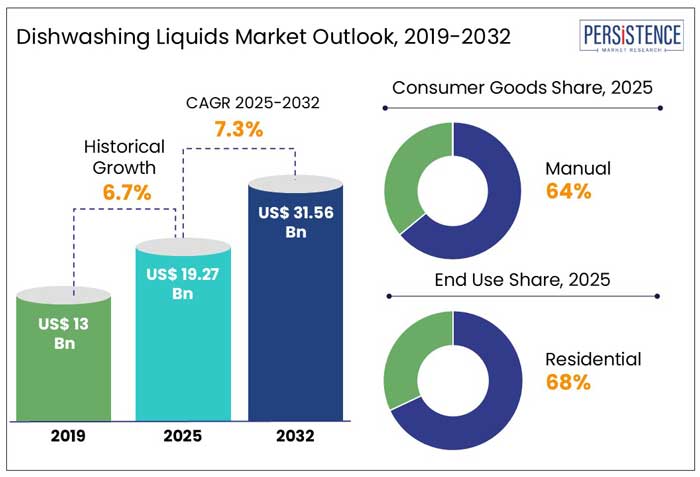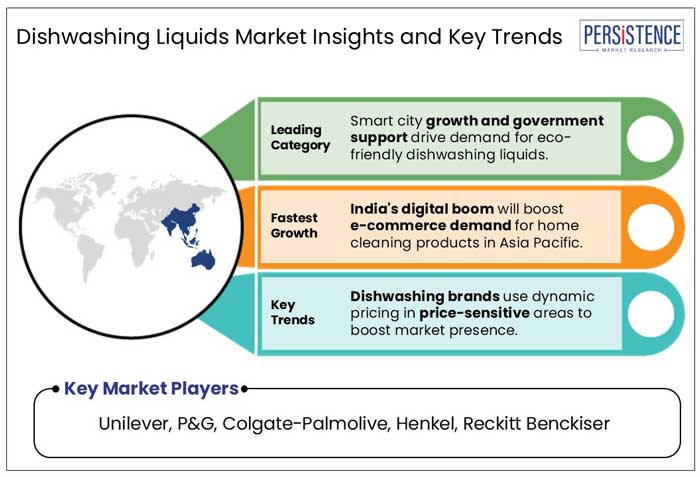Industry: Consumer Goods
Published Date: March-2025
Format: PPT*, PDF, EXCEL
Delivery Timelines: Contact Sales
Number of Pages: 186
Report ID: PMRREP33236
The global dishwashing liquids market size is estimated to reach a value of US$ 19.27 Bn in 2025 and is likely to witness a CAGR of 7.3% from 2025 to 2032. The market will likely attain a value of US$ 31.56 Bn in 2032.
Dishwashing liquids are manufactured using components like surfactants, fragrances, enzymes, preservatives, and dyes. Each component plays a crucial role in removing food residues, grease, and dirt from the dishes.
According to Persistence Market Research, dishwashing liquid companies operating in the market such as Unilever, P&G, and Colgate-Palmolive, among others, are focusing on adopting strategies such as product launches, partnerships, and mergers, which are likely to provide ample growth opportunities between 2025 and 2032.
Cascade’s partnership with comedian Kenan Thompson is a marketing strategy designed to increase consumer confidence and engagement with the product. Further, this is expected to aid in increased sales as consumers are more likely to try a product backed by a well-known personality.

Key Highlights of the Dishwashing Liquids Market
|
Global Market Attributes |
Key Insights |
|
Dishwashing Liquids Market Size (2025E) |
US$ 19.27 Bn |
|
Market Value Forecast (2032F) |
US$ 31.56 Bn |
|
Projected Growth (CAGR 2025 to 2032) |
7.3% |
|
Historical Market Growth (CAGR 2019 to 2024) |
6.7% |
Historical Period: Companies Adapted to Evolving Consumer Behavior & Sustainability Trends
During the historical period between 2019 to 2024, the global dishwashing liquids industry witnessed a CAGR of 6.7%. The COVID-19 pandemic had a transformative impact on the consumer goods and retail sector. Consumers began to prioritize health and hygiene leading to a surge in demand for homecare products, including dishwashing liquids.
Major brands focused on introducing eco-friendly and chemical-free formulations catering to the evolving customer demands. For instance,
In 2022, Unilever announced the global launch of a sustainable laundry capsule to help decarbonize the laundry process while delivering effective cleaning performance. The new capsules were available in a plastic-free, paperboard contained, a strategic move by the company to prevent over 6,000 tons of plastic from entering the waste stream every year.
Rising E-commerce Sector to Boost Demand for Dishwashing Product Subscription Model
The dishwashing liquids market is projected to showcase a CAGR of 7.3% from 2025 to 2032. The rise of the e-commerce sector is likely to be a key growth driver in the industry. Online platforms offer the convenience of 24/7 shopping and home delivery, especially in areas with limited availability of physical stores. Further, they provide consumers with easy price comparisons between brands and retailers, helping them make informed decisions.
In the U.S., companies offer subscription services for cleaning products through e-commerce platforms. This ensures customer loyalty and recurring sales by providing selected product deliveries, limiting the need for repetitive manual purchases. For example,
Blueland offers a subscription-based service for its eco-friendly dishwasher detergent tablets. These tablets are manufactured using mineral and plant-based ingredients. According to the company, this subscription model has positively contributed to their overall revenue. Moreover, it has helped them to enhance customer engagement, promote sustainability, and provide cost-effective services.
Increasing Demand from Primary & Secondary Housing Sectors to Spur Market Growth
Consumers in both primary and secondary housing sectors require easy-to-use and efficient cleaning products on account of their busy lifestyles. Besides, the growing emphasis on cleanliness and hygiene, especially since COVID-19, is projected to drive the demand for eco-friendly products in these sectors.
According to Fitch Ratings, the global housing market trends in 2025 are expected to be generally positive. This factor presents a significant opportunity for dishwashing liquids manufacturing companies to strengthen their presence with growth strategies such as product launches and partnerships.
Pricing Sensitivity in Emerging Economies May Hamper Growth Prospects
In emerging economies, price sensitivity among consumers is anticipated to limit the adoption of premium or specialized dishwashing liquid products. People, being highly price-sensitive in emerging economies, often prefer cheaper alternatives like dishwashing bars. This preference is driven by economic constraints and the perception of bars offering better value for money. Further, liquid dishwashing products are generally more expensive than traditional bar soaps. This difference may deter budget-conscious consumers from adopting liquid detergents. For instance,
As per a case study, in Thailand, most consumers preferred dishwashing liquid prices at US$ 0.89 for an 800 ml bottle and US$ 0.59 for a refill package. In addition, during trial purchases, consumers initially bought 1-2 bottles and later opted for refill packages once they were satisfied. This case study highlights how economic consideration is anticipated to be a critical challenge in the market, particularly in emerging regions with economic constraints. Moreover, addressing this challenge will require a strategic marketing effort and product differentiation by companies during the forecast period.
Adoption of Dynamic Product Pricing Strategies by Companies to Create New Growth Opportunities
Companies operating in the global dishwashing liquids sector are focusing on strengthening their positions by leveraging dynamic pricing strategies and other key business tactics. The utilization of AI-driven algorithms to adjust prices based on real-time demand, competitor analysis, and consumer behavior by companies is likely to boost the adoption of the product in the forthcoming years. For instance,
Unilever implements regional dynamic pricing strategies for its Sunlight brand while offering discounts in price-sensitive markets such as APAC and maintaining higher prices for premium offerings in developed regions of North America & Europe.
Manual Dishwashing Segment to Dominate Backed by Increasing Demand for Eco-Friendly & Natural Products
Based on operation, the manual dishwashing segment is projected to dominate and hold a share of 64% in 2025.
Manual dishwashing liquids are formulated to create lot of suds, which helps to remove grease and food particles. Owing to their convenience and efficiency, manual dishwashing products are in huge demand compared to traditional soap bars. Moreover, growing preference for eco-friendly, non-toxic, and biodegradable manual dishwashing liquids globally is anticipated to boost the adoption of the product during the forecast period. For example, brands like Seventh Generation and Ecover Zero have successfully launched their biodegradable and plant-based dishwashing liquid formulas, appealing to eco-conscious consumers.
Automatic dishwashing segment, on the other hand, is expected to witness substantial growth. Individuals with busy schedules prefer time-saving and efficient dish cleaning solutions driving the demand for dishwashers. Urbanization, changing lifestyles, and the desire for convenience are leading people to use dishwashers, which in turn boosts the need for specialized automatic dishwashing liquids.
Economic Growth Drives Household Shift to Premium Dishwashing Liquids
Based on end use, the household segment is projected to hold a significant market share of 68% in 2025. Households in urban areas often prefer dishwashing liquids due to their ease of use and effective cleaning capabilities. As economies grow, households have more disposable income to spend on premium and convenient products. This economic growth supports the consumption of dishwashing liquids over traditional alternatives. Besides, the penetration of e-commerce in rural households is expected to drive product demand during the forecast period. E-commerce companies like Amazon have made significant efforts to cover rural areas, with delivery services available in 90% of villages in India.
On the other hand, the commercial segment is likely to witness considerable growth during the forecast period. Bulk buying from HoReCa (Hotel, Restaurant, and Cafe) and the growing demand for effective cleaning & sanitation in commercial kitchens are factors driving the demand for dishwashing liquids across the commercial sector.

Increasing Consumption of Cleaning Products in China and Japan to Bolster Market Growth
Asia Pacific is anticipated to dominate the global dishwashing liquids industry with a share of about 33% in 2025. This region is expected to witness substantial growth on account of urbanization, economic factors, technological innovations, and shifts in consumer behavior toward sustainability.
Major companies such as Unilever and Reckitt Benckiser are focusing on expanding their product portfolios to capitalize on the rising demand for home cleaning products in China and Japan. Moreover, to generate significant revenue companies are focusing on introducing liquid soaps over traditional bars. For instance,
The market for dishwashing liquids in India presents a promising outlook. Factors such as rapid expansion of the e-commerce and retail sector, significant lifestyle changes, and supportive government policies are anticipated. For example, government initiatives such as Swachh Bharat Mission, emphasize the importance of household hygiene, which is likely to boost the demand for cleaning products.
India’s e-commerce landscape is poised for tremendous growth in the forthcoming years. With a projected 1.3 billion internet users by 2030, digital commerce is expected to be the primary online activity for Indians. According to a research report from Bain & Company in collaboration with Google, India’s digital economy is expected to grow six-fold in the near future, and is set to be valued at US$ 1 trillion by 2032.
The rising e-commerce sector is anticipated to boost the adoption of dishwashing liquids on account of enhanced accessibility and convenience for consumers.
Availability of Multiple Utensil Cleaning Products to Spur Demand in North America
North America is expected to hold a market share of 29% in 2025. The region is experiencing significant growth driven by consumer preferences for convenience, sustainability, and efficiency.
Companies like Procter & Gamble (P&G), Colgate-Palmolive, Henkel, Kao Corporation, and others are focusing on introducing eco-friendly products to strengthen their hold on the market. Further, dishwashing liquids industry players in the U.S. are adopting expansion strategies through sustainable packaging, innovation in formulation, and expanding manufacturing facilities to cater to consumer demands.
Stringent Government Regulations on Single-Use Packaging Compels Companies to Adopt Novel Strategies
The market for dishwashing liquids in Europe is projected to grow considerably, with a share of 26% in 2025. Stringent government regulations for single-use packaging and increasing awareness regarding home hygiene are factors contributing to market growth in this region. For instance, The European Union’s Packaging and Packaging Waste Regulation (PPWR), effective by 2025, mandates a transition from single-use to reusable packaging, with specific reuse targets set for the forthcoming years. This regulation is anticipated to impact how companies design their packaging strategies.
In 2024, Ocado Retail announced trials of reusable containers for home essentials ordered through online mode. Staged in two phases, the trial involves use of a specially designed reusable vessel to deliver laundry products.
The global dishwashing liquids industry is witnessing fierce competition among the leading market players. Adoption of strategies such as investments in research and development and product innovation by companies to enhance their footprint and strengthen their presence will aid in significant market growth during the forecast period.
Major players like Unilever, Godrej Consumer Products, Blueland, Bombril, and others are primarily focusing on expanding their market presence across Tier-2 and Tier-3 cities. These companies are implementing strategies such as undertaking promotional activities, providing discounts, and e-commerce integration. For example, Unilever is transforming its go-to-market approach to effectively serve smaller format stores and fast-growing online channels in lower-tier cities. This strategy is anticipated to strengthen its position in emerging regions.
|
Report Attributes |
Details |
|
Historical Data/Actuals |
2019 - 2024 |
|
Forecast Period |
2025 - 2032 |
|
Market Analysis Units |
Value: US$ Bn/Mn, Volume: As applicable |
|
Geographical Coverage |
|
|
Segmental Coverage |
|
|
Competitive Analysis |
|
|
Report Highlights |
|
|
Customization and Pricing |
Available upon request |
By Packaging
By Operation
By End Use
By Sales Channel
By Region
To know more about delivery timeline for this report Contact Sales

The market is set to reach US$ 19.27 Bn in 2025.
The industry will likely be valued at US$ 31.56 Bn in 2032.
P&G, Unilever, Colgate-Palmolive, and Henkel are a few leading players.
The industry is estimated to rise at a CAGR of 7.3% through 2032.
Asia Pacific is projected to hold the largest share of the industry in 2025.